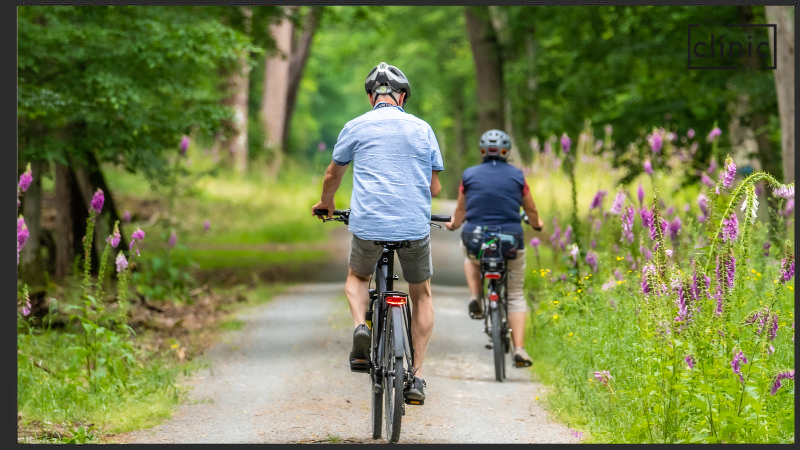Cycling and Low Back Pain

Cycling in Calgary, Alberta has seen a spike in popularity. Trading the car for a bicycle has become the newest trend whether it be for exercise, enjoyment, training for a race, cross-training, or simply a way to protect the environment from unnecessary emissions.
A recent article in the European Journal of Sports Science indicated an association between sports activities and low back pain. They found that people who engage in running or cycling have less low back pain. So why then, do many cyclists complain of low back pain symptoms?
Lower Back Pain (LBP) can cause problems for cyclists for a number of reasons. The easiest explanation is the prolonged bending of the back. Most cyclists spend long periods of time in a fixed position. A poorly fit bike or bad body position on the bike can lead to lower back pain due to abnormal wear to the joints along the spine and a number of muscular imbalances.
How to Prevent Lower Back Pain
There are a few tools you can use to help fight lower back pain while you hit the road on your bike.
- Form
- As with anything to do with the spine, posture is important. Always maintain a neutral spine by bending at the hips and avoid hunching your mid-back. Your spine naturally has a curve to it; this should be maintained while riding but not overemphasized or flattened. It is often difficult to evaluate your own posture so it is worth having someone look at your body position on your bike or use a trainer in front of a mirror.
- Equipment
- A poorly fit bike may also be the cause of your lower back pain; being either too stretched out or compacted by your bike can result in abnormal stresses to your back.
- ALWAYS wear a helmet
- Adjust the saddle so that in the bottom pedal position there is a 10-degree bend in your knee
- Choose the right bike – in straddle position and with a properly aligned bike a 1-inch clearance will be left between the groin and the top of the frame
- The stem height should be somewhere between parallel and 1-inch lower than the top of the saddle
- Padded shorts can provide comfort on longer rides
- Use UV sunglasses to protect your eyes
- Most local bike shops have trained staff that can assist you with ensuring your bike is the correct size for you as well as any minor adjustments required to fit the bike to your body.
- Muscle imbalance and Overtraining
- With any activity, this is quite common, in cyclists certain muscles will be strengthened while other supporting musculature may not. Adding in resistance training as a cross-training exercise is beneficial as it can strengthen the stabilizing muscles. Increases in muscle mass equal increases in endurance capacity. As you ease your way back into the sport, it is important to start out slow and not seek massive gains in distance, speed, time or effort too quickly. Your body will need time to adjust to a change in a new activity.
Bike Fitting Recommendations To Reduce Lower Back Pain
Saddle height: Start by adjusting the saddle to the height of your hip bone. Sit on your bike and place your heel on the pedal with your leg extended to the bottom of your pedal stroke. If you have a slight bend in your knee your seat is at the right height. Setting the seat too low results in increased strain on your knees.
Saddle position(forward/backward): Ensure that your knees come slightly over the center of your foot but do not extend past the middle of your shoelaces. A position that is too far back will cause unnecessary strain on your knees and low back and a too far forward position will decrease your riding efficiency
Handlebars: your ideal handlebar placement should allow you to ride comfortably without requiring you to put much weight into the handlebars. You should be close enough to your seat to keep a slight bend in your elbows. A position that is too low will lead to discomfort in the low back and put unnecessary tension into the neck and shoulders.
Pedal position: The ball of your foot should sit on the center of your pedal. Your foot stroke should keep your heels level with the ball of your feet. Pointing your toes down through the pedal stroke will result in numbness in your feet, as well as increased stress through the ankles and knees.
If you are experiencing pain, numbness or tingling or other MSK problems while riding, come visit one of the chiropractors at Centennial Wellness for an assessment. We will be able to provide treatment and education to treat these problems to help reduce injury. You can book a chiropractic appointment online by clicking here.
References:
- Alberta College and Association of Chiropractors website: https://albertachiro.com/ACAC/ACACBlog.aspx
- Cross-Sectional associations between the diversity of sports activities and the type of low back pain in adulthood – European Journal of Sports Science – Dec 19, 2019: 1-9.
A Holistic Approach To Health
Our Services
Our Treatments
Calgary’s Choice For Optimal Wellness
Every person’s journey to complete wellness is unique. Achieving optimal health may be easier than you thought, or it might be harder than you expected. But when you partner with the team at The Clinic YYC, you are guaranteed access to some of Calgary’s best wellness professionals and to effective and transformative traditional and advanced treatment modalities to support your goals for physical well-being.
Connect with The Clinic YYC by filling out our contact form, calling us at 1-587-353-5933, faxing us at 1-587-353-5471 or visiting us! We are located in the ECT Tower on the main floor by the north entrance.


